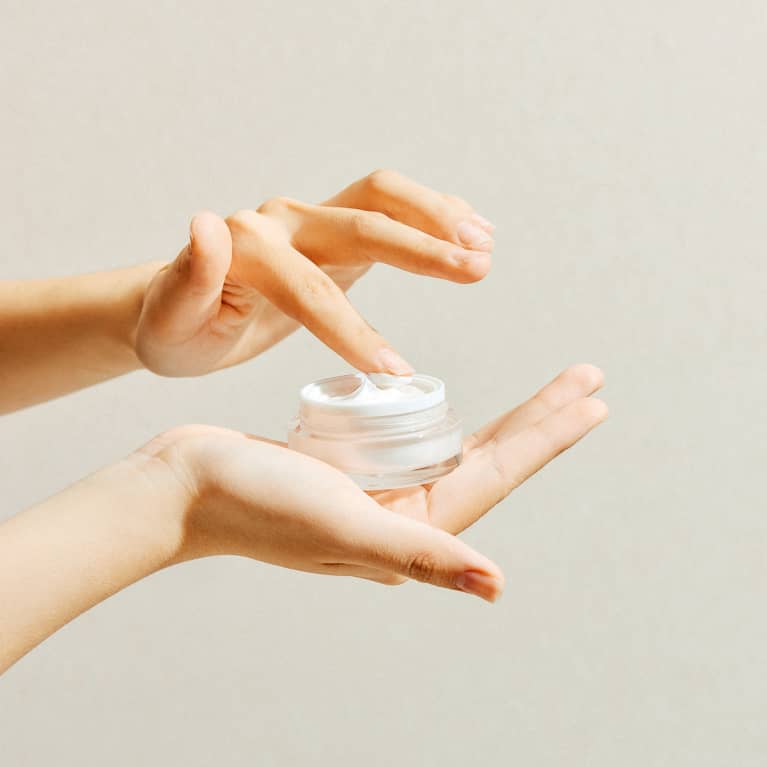
Why Is This Cream Called The Gold Standard By Derms? We Break Down Retin-A
by mbg Beauty and Lifestyle Senior EditorIf you know skin care, you might have heard or read about retinols and why so many are a fan of this healthy aging active. Or you might have heard one of the many names the group of ingredients goes by: retinoic acid, retinoids, Retin-A. And that last one gets a bit tricky, as it's technically not a type of retinols but rather a brand.
What is Retin-A?
Retin-A is a prescription-strength, brand-name product that falls under the retinoid class of ingredients. Retinoids are derived from vitamin A and have been shown to have many benefits when used topically: "It helps speed up skin cell turnover and increase collagen synthesis. This, in turn, helps to target fine lines, pigmentation, and, at higher doses, acne," says board-certified dermatologist Jennifer Herrmann, M.D. There is a reason derms have dubbed it "the gold standard."
Retin-A, specifically, has become the catchall for almost all prescription-strength vitamin A derivatives—sometimes it's even mistakenly used to describe over-the-counter retinoids too (those are technically called retinols, though). Compare it to facial napkins: You may ask someone to kindly pass you a Kleenex, when you're not really asking for that specific brand—you're just referring to any tissue. Or more aptly, perhaps you ask a friend for an Advil when you have an ache; you are likely just looking for any form of ibuprofen.
How did Retin-A get so lucky to become the proprietary eponym? Easy: It was the first. Debuting as a patented, FDA-approved acne-treatment in the early '70s, it quickly became equally loved for its healthy aging benefits too. After the patent expired, generic versions (tretinoin) and other brand name versions with slightly different formulas popped up (like Tazorac and Differin). Less potent OTC options appeared, too. But Retin-A has remained the most recognizable.
Skin care benefits.
Retin-A and prescription retinoids have many skin care benefits. "Certainly, it's a key ingredient for those with acne, but it is helpful for healthy aging as well," says Hermann.
- Acne. Acne is the prescription's historical and intended use. The way it does so is twofold: First, alters the genes involved with inflammation and cell growth. This reduces the formation of microcomedones, or skin pores clogged with sebum, bacteria, and dead skin cells. (As these are the precursors to blemishes, you can stop breakouts before they form by stopping microcomedones.) From there, it also helps clear pores superficially by acting as a chemical exfoliant of sorts as it sloughs off dead skin cells. Finally, it's also a beloved treatment for acne scars.
- Collagen. Acne may have been its first use, but collagen-production has certainly become its most famous. "Retinol binds to retinoid receptors within skin cells," says board-certified dermatologist Joshua Zeichner, M.D. This "activates genes that upregulate collagen production." This effect by numerous studies, where retinol treatment stimulated collagen production in mature skin, helping decrease the appearance of wrinkling.
- Overall quality. Retin-A improves your skin's appearance in a variety of other small ways (Usually as a result of skin cell acceleration or from the enhanced collagen production.) These include: smaller, tighter-looking pores, faded dark spots, improved post-inflammatory hyperpigmentation, increased vibrancy, smoothed fine lines, and less sagging.
Side effects.
"It cannot be used during pregnancy," says Hermann, as some studies have linked it to birth defects (the main link is through oral vitamin A derives, so doctors are less sure how strong the link is when used topically). Given there is no scientific consensus on this matter, it is best to avoid it to be safe.
One of the most notorious side effects is the dry skin, flaking, and redness that come in the first few weeks. "Typically, it does cause initial irritation as the skin acclimates. This tends to subside over consistent use," says Hermann.
Finally, some people simply find the ingredient too harsh—and no transition period will get you to the other side. "For those with rosacea or sensitive skin, Retin-A can be difficult to tolerate," says Hermann. This is because these individuals may already have a compromised skin barrier—and so accelerating skin cell turnover will only lead to more permeable and irritated skin.
How to use it.
You should apply Retin-A on freshly washed skin at night. It should only be used at night as it causes photosensitivity, or increase irritation from the sun. You can follow it with your evening skin care routine as normal. Just be mindful that Retin-A is an exfoliator, and so the rest of your skin care products should err on the side of gentle (read: don't mix Retin-A with a glycolic acid serum). "If using it for cosmetic purposes, typically a low dose is used very sparingly over your face a few times weekly, then increased to nightly if tolerated," says Hermann.
As for the amount, "less is more," says Hermann. "Typically a pea-size amount of cream is all that is needed for the entire face. If you have trouble spreading it, it can be mixed with a little light moisturizer or serum to help it spread farther."
Or, as a tip from Zeichner: If you tend to have easily irritated skin, you can layer your Retin-A on top of your moisturizer. This way, the ingredient is buffered by your hydrating ingredients and doesn't penetrate the skin as easily.
The takeaway.
The retinoid family are game-changers in skin care, which is why most derms recommend some version of it. Retin-A is the most famous brand-name prescription as it was the first, but you can get various other OCT (and even natural) versions if you're not ready to head to the derm's office.